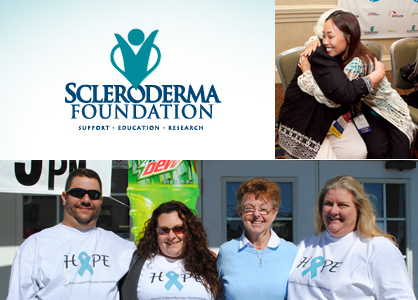Scleroderma: A vicious disease
To Kerri Connolly, scleroderma is a personal cause: She watched her mother suffer from it for 17 years. When her mother’s symptoms developed in 1992, there was little information about the disease. She went from doctor to doctor, complaining of fatigue and puffiness, and was told to go home – there was nothing wrong. She was even told to see a psychologist, who offered no relief. After developing more serious symptoms, she landed in the hospital.
“The doctors were pulling out their hair because they couldn’t quite understand what this mystery was,” Kerri Connolly said, reporting it took another four years before her mother would be diagnosed. By that time, she was almost in full renal failure. She was told to go home and make her funeral arrangements; she only had one year left to live. Connolly turned to the Scleroderma Foundation to cope, and the support she received later inspired her to become the charity’s programs and services director, a position she still holds today.
Scleroderma means “hard skin.” Patients experience a hardening and thickening of not just their skin, but often their internal organs – causing the organs to have difficulty functioning. Issues such as lung scarring and hardening of the heart can produce serious complications and even death, while digestive problems prevent patients from absorbing nutrients, causing them to literally waste away. Pulmonary arterial hypertension – high blood pressure within blood vessels supplying the lungs—is also common and causes a high number of fatalities among scleroderma patients.
Considered a rare disease, scleroderma is an autoimmune disorder that affects approximately 300,000 Americans. Scleroderma is an umbrella diagnosis, as the disorder appears in multiple forms, including localized, in which only the skin is affected, and systemic, a more severe form that extends to the organs.
For some unknown reason, scleroderma hits women three to four times more often than men. For the children who develop it, the disease is particularly viscous.
Twenty odd years ago, the outcome for scleroderma patients was bleak. Today, since there is a better understanding of the disease, the future is more promising for patients, who have greater treatment options.
Each day is different for scleroderma patients. “You never know what you’re going to get, and that is the most difficult thing about this disease,” Jayme Kornfeld, interim vice president/secretary and a support group leader, who has scleroderma herself, said.
The fatigue is not ordinary lethargy, but rather can be, as Kornfeld described, “devastating.”
“You get very, very tired doing simple, everyday tasks,” she reported, maintaining that symptoms vary from patient to patient, and include high levels of pain, circulation problems where the hands change color from lack of blood, severe gastrointestinal issues and such susceptibility to cold that it is a problem to shop in the freezer section of the grocery store.
“It’s just these little, everyday things you take for granted when you are healthy that are difficult for people with scleroderma,” Kornfeld explained.
While medication can help treat symptoms, there is no cure. Kornfeld personally takes 16 different types of pills, each one addressing a different aspect of her disease. Patients who receive treatment early can likely live a full life—with minor adjustments.
“We are not able to do the things we used to do anymore,” she explained. “Our bodies just don’t make that possible anymore.”
Kornfeld reports when she was first diagnosed, she didn’t know where to turn.
“I put my head in the sand and I pretty much just ignored it for the first couple years,” Kornfeld said. “And I got thicker and thicker.”
After getting laid off – due to her scleroderma – and experiencing a host of personal problems, she finally decided to reach out to others who shared her condition. At the time, she had never met anyone else with the disease and knew little about it, despite having lived with it for years. Speaking with the Northern California chapter president changed her life.
“My life totally turned around. I had a different outlook on the disease,” Kornfeld reported. “I had a desire to help other people not go through the same things I went through.” She loved the foundation’s support and education, aspects she claimed other organizations often neglect in favor of focusing on research.
The Scleroderma Foundation, a national nonprofit health organization, helps people with scleroderma through a trifold mission of support, education and research. Most of its money is channeled into research to find a treatment, cause or cure. Boasting 145 support groups across the United States, the charity offers educational literature and events to clear up confusion about the disorder.
“(Patients) finally get a diagnosis – sometimes it takes years – and scleroderma can be very complicated,” Connolly said. “So we offer a number of different educational components to assist the patient to get a better grasp on the disease.”
The foundation has raised more than $16 million for research, as well as obtained congressional funding, and sponsors a peer-reviewed research program with “only the best and the brightest.”
Awareness, as always, is critical, as many are unfamiliar with the disease and its implications. Even doctors can be uninformed.
“There’s a lot of misunderstanding about the disease,” Kornfeld revealed. “A lot of doctors don’t have updated information and there are lots of doctors that tell patients that the disease is fatal and that they’re going to die shortly.”
For more information about the Scleroderma Foundation or the disorder, visit www.scleroderma.org.
Do you know someone with scleroderma or do you have it yourself? What is it like to live with?
Tagged in: lux exclusives, charity, nonprofit, philanthropy, disease, scleroderma, scleroderma foundation,

Purple Neon/LadyLUX via Scleroderma Foundation



